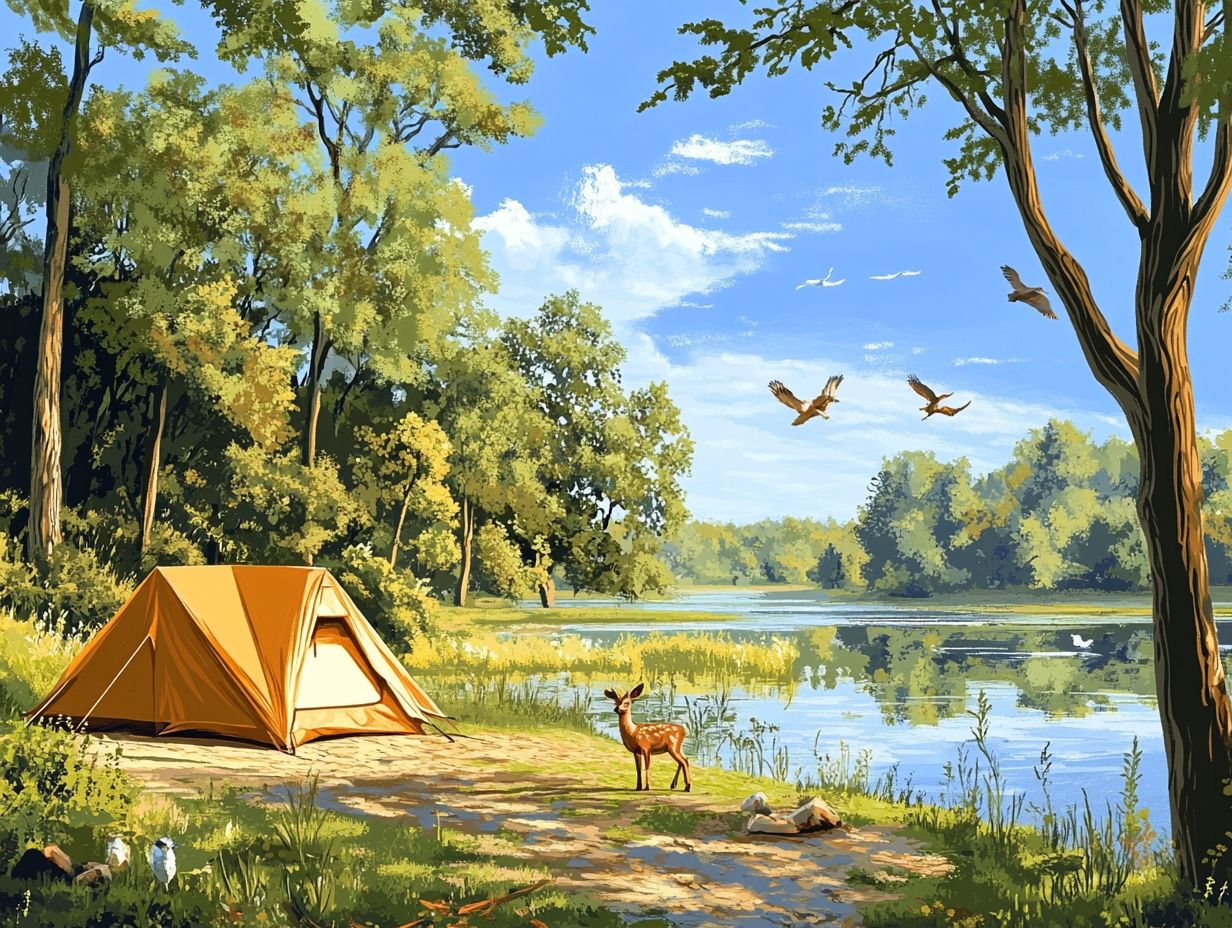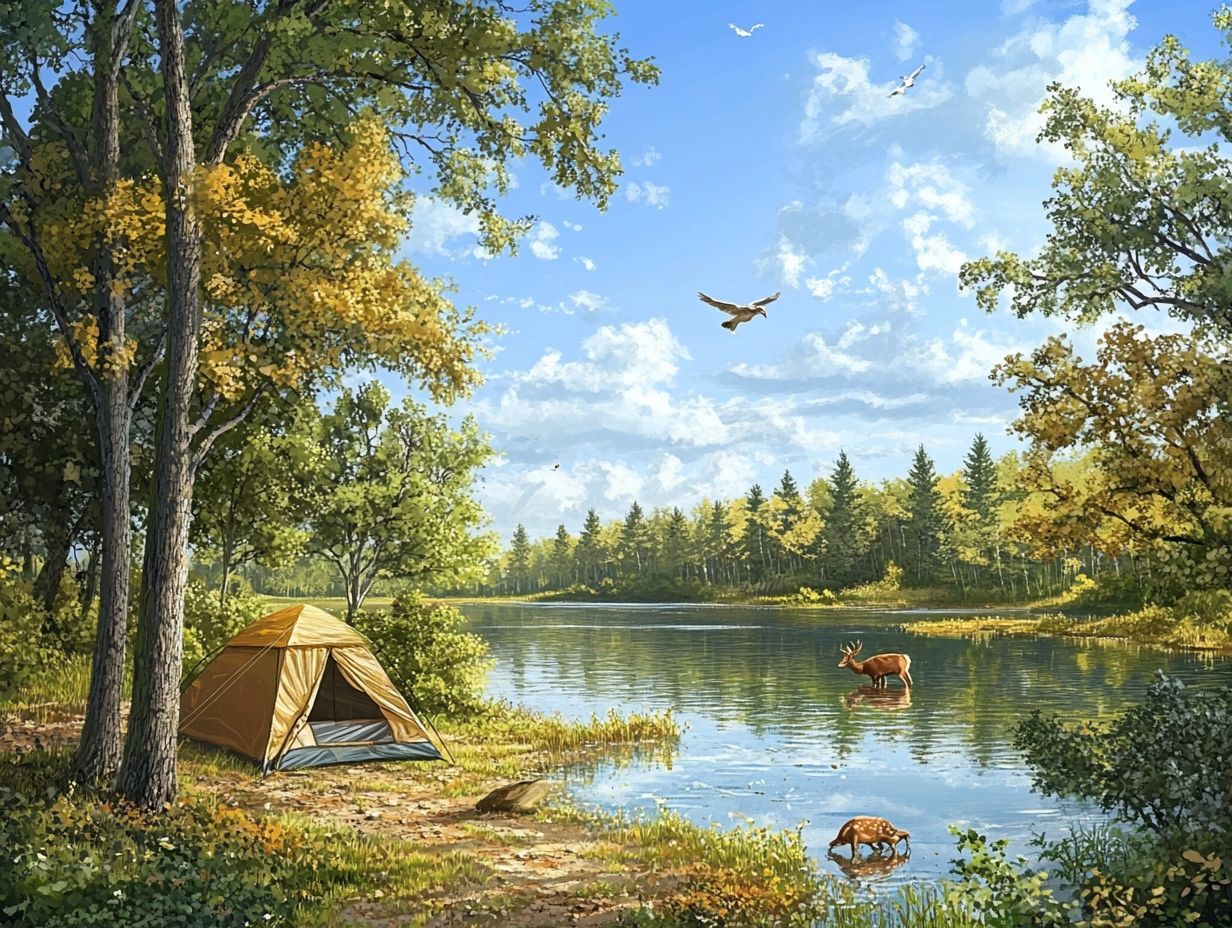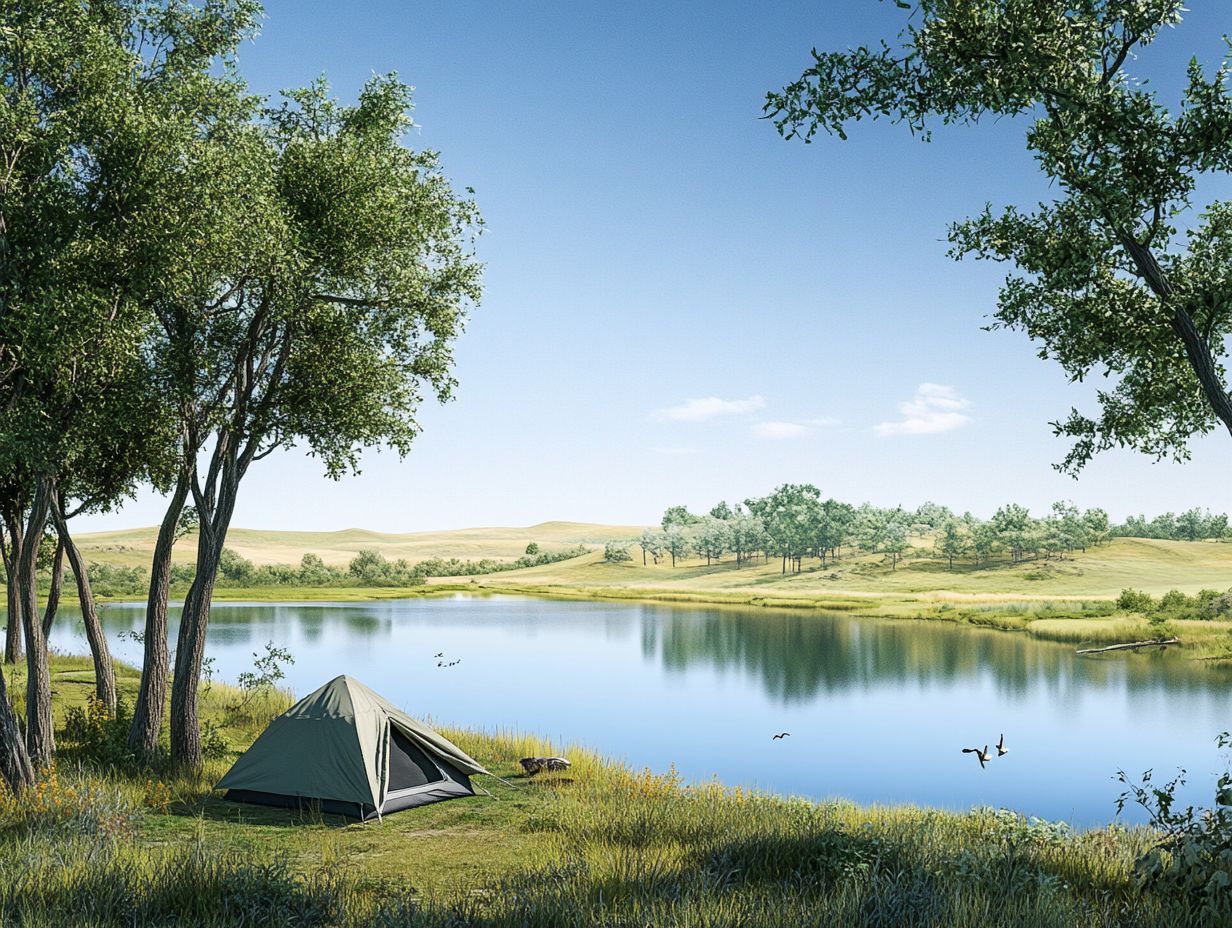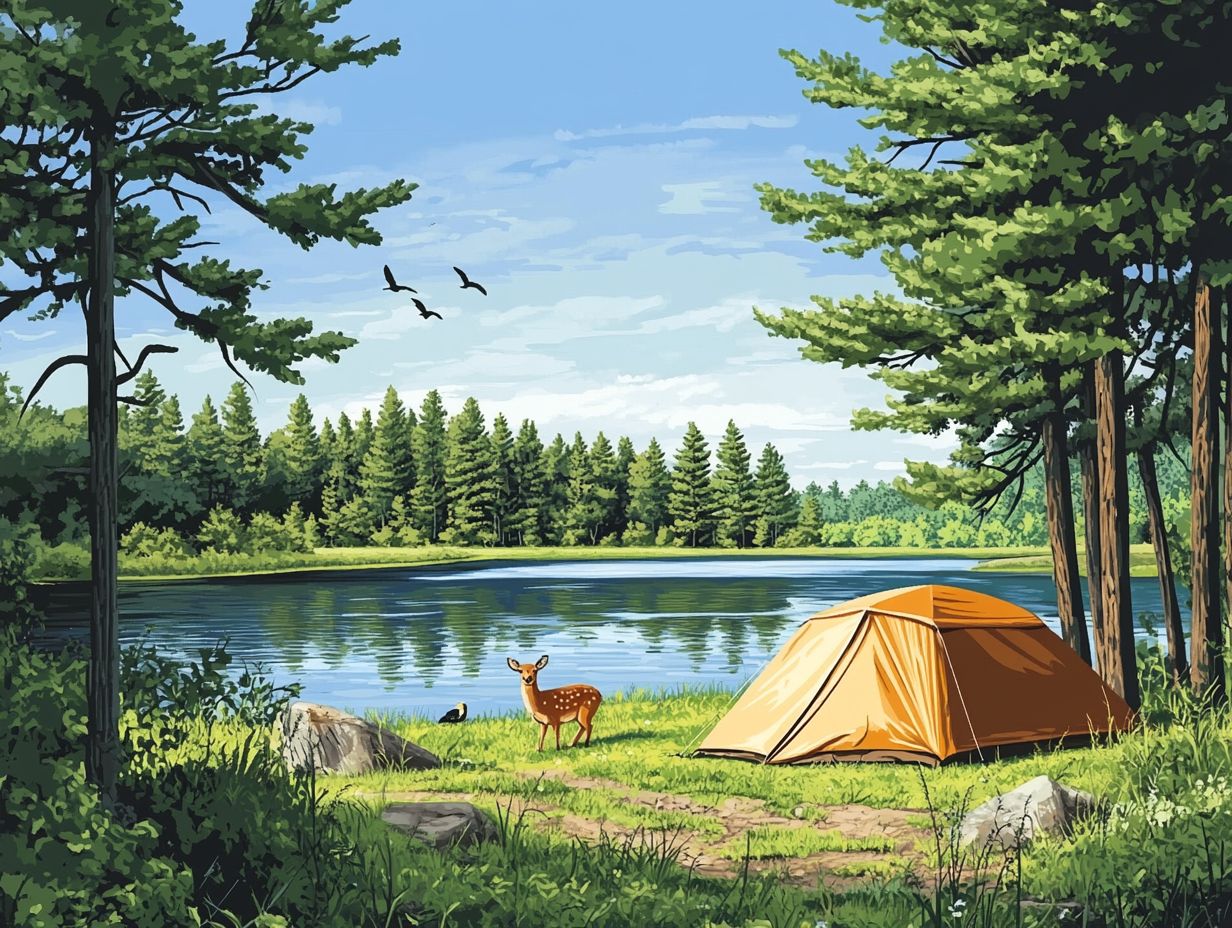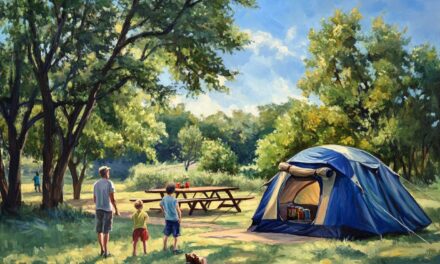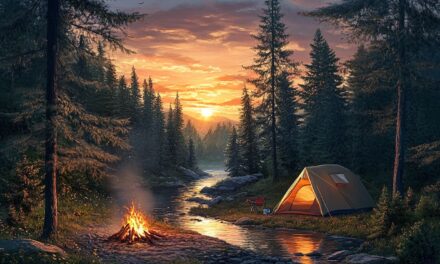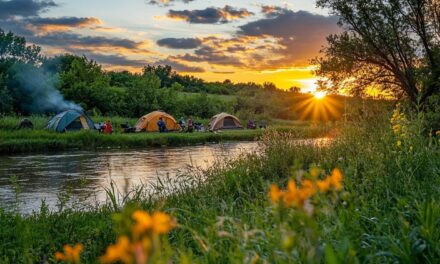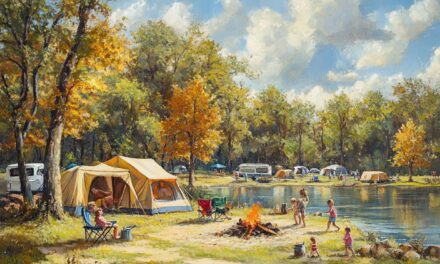Nebraska’s diverse landscapes are home to an array of wildlife, making it a prime destination for outdoor enthusiasts and nature lovers alike.
Choosing the perfect campsite can enhance your wildlife viewing experience, allowing you to connect with the natural world in unique ways.
This guide highlights ten of the best camping spots across Nebraska, each offering stunning scenery, abundant wildlife, and special benefits that make them stand out.
Discover where to camp for unforgettable wildlife encounters in the Cornhusker State!
What to Consider When Choosing a Wildlife Viewing Campsite
Choosing the perfect wildlife viewing campsite in Nebraska requires a thoughtful consideration of various factors that enhance your outdoor experiences. With Nebraska’s diverse habitats, including state parks and recreational areas, each site offers unique opportunities for wildlife enthusiasts to connect with nature. As you explore these camping spots, pay attention to the available amenities, the types of wildlife you might encounter, and the specific activities such as hiking and fishing that can elevate your visit. Evaluating these elements ensures a fulfilling experience, allowing for delightful encounters with bird species and other local wildlife.
Fort Niobrara National Wildlife Refuge
Fort Niobrara National Wildlife Refuge, located in the captivating Sandhills of Nebraska, is a must-visit destination for wildlife enthusiasts who seek an immersive camping experience in nature. This refuge spans over 19,000 acres and features diverse habitats, allowing for exceptional wildlife viewing opportunities and scenic vistas that showcase the beauty of Nebraska’s natural landscape. The refuge is renowned for its hiking trails that meander through lush grasslands, providing access to stunning overlooks and chances to spot various bird species during spring migration or year-round residents.
Location and Description
Fort Niobrara National Wildlife Refuge is located in north-central Nebraska, near the charming town of Valentine, and is easily accessible for visitors seeking a wildlife viewing experience in the scenic Sandhills region.
This stunning refuge spans over 19,000 acres and features a mesmerizing mix of rolling hills, lush riparian areas, and a variety of ecosystems that showcase the natural beauty unique to this part of the Great Plains.
Just a short drive from Valentine, the refuge offers an excellent opportunity for nature lovers to explore rich biodiversity. It is particularly famous for its bison and elk populations, which are a throwback to Nebraska’s pioneering past, creating a living tribute for those interested in the region’s wildlife history.
Visitors can embark on:
- nature hikes on well-marked trails
- birdwatching excursions
- picnics amidst stunning vistas
while enjoying the peace of the refuge. The surrounding Sandhills area is not just a geological marvel; it also holds significant historical context as it was once traversed by early settlers and the Native American tribes, making it a point of interest for those keen on Nebraska’s heritage.
Wildlife to See
Visitors to Fort Niobrara National Wildlife Refuge can expect to see a rich variety of wildlife, including majestic golden eagles that soar above, migratory sandhill cranes during their seasonal journeys, and the graceful white-tailed deer that roam the landscape.
As the seasons shift, so too does the wildlife presence within the refuge, creating a dynamic experience for nature enthusiasts. In the early spring, animal visibility dramatically increases as the refuge becomes a crucial stopover point for migratory species, offering a rare chance to observe flocks of geese and the striking sight of red-tailed hawks returning to their nests.
During the summer months, visitors may find that the thick foliage makes spotting wildlife more challenging, yet this time also brings out vibrant bird species such as the indigo bunting. As autumn rolls in, the scenery transforms further, and species like the elk begin their rutting season, making it an ideal time for wildlife watchers to immerse themselves in this natural spectacle.
- Golden Eagles: Often seen soaring in the crisp sky.
- Sandhill Cranes: Notable for their annual migration.
- White-tailed Deer: Commonly observed throughout the refuge.
- Red-tailed Hawks: A frequent sight returning in the spring.
- Indigo Buntings: A vibrant summer addition to the refuge.
- Elk: Active during the fall rutting season.
Benefits of Camping Here
Camping at Fort Niobrara National Wildlife Refuge offers numerous benefits, including unparalleled nature immersion and the chance to engage in outdoor activities that connect visitors with the natural world. Here, you can experience a harmonious blend of education and recreation.
This refuge provides a wealth of educational programs that cater to all ages, promoting awareness and appreciation for the diverse ecosystems found within. Visitors are often delighted to participate in:
- Guided Nature Tours: Explore the stunning landscapes while learning about local flora and fauna.
- Wildlife Management Practices: Gain insight into conservation efforts and how they impact the habitat and wildlife.
- Junior Ranger Programs: Engage younger campers with hands-on activities focused on environmental stewardship.
The recreational opportunities here are plentiful, allowing outdoor enthusiasts to hike, birdwatch, and even partake in photography as they capture the beauty of this unique setting.
Camping amenities, such as convenient campgrounds and picnic areas, further enhance the visitor experience, making it an ideal location for both relaxation and adventure.
Smith Falls State Park
Smith Falls State Park, home to Nebraska’s tallest waterfall, provides an exceptional backdrop for wildlife viewing and outdoor activities, making it a favorite among families and nature lovers alike. This picturesque park offers various hiking trails that wind through scenic landscapes, allowing visitors to experience the beauty of the Niobrara River and the diverse wildlife it supports. With plenty of camping spots and family-friendly amenities, Smith Falls invites outdoor enthusiasts to immerse themselves in nature while enjoying birdwatching opportunities and exploring the park’s historical significance.
Location and Description
Located near the quaint town of Valentine, Smith Falls State Park encompasses 703 acres of natural beauty and is defined by the stunning Smith Falls, which cascades 70 feet into a rocky gorge.
The park is positioned within the scenic Niobrara River Valley, offering visitors easy access to a range of outdoor activities. Nestled between towering trees and vibrant wildlife, this gem of Nebraska parks invites nature enthusiasts to explore its hiking trails, many of which wind their way along the river and provide breathtaking views of the falls.
- Whether you’re a seasoned hiker or a family looking for a day out, there’s something for everyone.
- The trails vary in difficulty, accommodating both leisurely walks and more challenging hikes.
- The park is equipped with picnic areas, fishing spots, and camping facilities, allowing guests to immerse themselves fully in its serene environment.
Accessible via State Highway 12, Smith Falls State Park is a must-visit destination for anyone keen to experience the natural wonders that Nebraska has to offer.
Wildlife to See
Smith Falls State Park boasts a variety of wildlife species, including bird species such as sandhill cranes and white-tailed deer that are often spotted near the trails and riverbanks.
As you explore the lush landscapes, you may also encounter an array of other fascinating wildlife, particularly during different seasons.
- In spring, the park becomes alive with the vibrant colors and songs of neotropical migratory birds such as the warbler and tanager, offering a perfect opportunity for avid birdwatchers.
- Summer brings with it a surge in activity from red-tailed hawks and eastern bluebirds, often seen soaring gracefully above the greenery.
- As autumn approaches, the tranquil sights of migrating waterfowl, including geese and ducks, can be observed along the water’s edge.
- During winter months, one might catch a glimpse of majestic bald eagles perched in the tall trees, as they search for food amidst the snow-covered landscape.
Benefits of Camping Here
Camping at Smith Falls State Park provides numerous benefits, including the opportunity for outdoor adventures such as fishing in the Niobrara River and hiking through trails with breathtaking views, all of which play a significant role in promoting well-being and connectivity with nature. Families can enjoy a variety of recreational activities that foster adventure and exploration, making this destination ideal for creating lasting memories together.
Plus outdoor adventures, the park offers educational programs focused on wildlife conservation, which help visitors appreciate the rich biodiversity of the area.
- Wildlife Workshops: Engage in hands-on learning experiences that introduce participants to local flora and fauna.
- Guided Nature Walks: Join knowledgeable rangers who discuss the ecosystems and their importance while exploring the picturesque landscape.
- Junior Ranger Programs: Kids can earn badges by completing fun activities that educate them about the environment.
Family-friendly activities abound, ensuring everyone, from toddlers to grandparents, finds something enjoyable. Whether it’s setting up camp under the stars, roasting marshmallows by the fire, or embarking on a canoeing expedition, these moments strengthen family bonds and instill a love for the outdoors.
Ponca State Park
Ponca State Park, nestled where the Missouri River meets the Nebraska landscape, is a premier destination for wildlife viewing and outdoor recreation, attracting visitors year-round. This sprawling park boasts miles of hiking trails that traverse scenic bluffs and wooded areas, offering breathtaking views and ample opportunities to observe wildlife in their natural habitats. With amenities designed for family-friendly camping experiences, Ponca is the ideal retreat for those looking to engage with diverse ecosystems and enjoy activities such as fishing, birdwatching, and nature walks.
Location and Description
Ponca State Park is located along the scenic Missouri River, bordered by bluffs and lush forests, offering a beautiful natural setting for visitors seeking wildlife viewing opportunities in Nebraska.
Stretching over 2,000 acres, this park is a stunning showcase of Nebraska’s natural beauty, making it a prime destination for outdoor enthusiasts. The rolling hills and dense woodlands create a picturesque backdrop for a variety of activities, including hiking, fishing, and camping. Visitors can explore numerous trails, such as the Riverside Trail, which provides breathtaking views of the river and its surrounding landscapes.
- Fishing enthusiasts will appreciate the abundant opportunities available on the Missouri River, where species like catfish and bass thrive.
- For those wishing to learn more about the area’s history, the park offers interpretive programs that delve into local wildlife and the significance of its unique geography.
The park’s historical significance is notable, as it was once a key point for Native American tribes, and now it stands as a testament to the preservation of Nebraska’s natural heritage. In addition, various seasonal events held throughout the year enhance the visitor experience, drawing attention to the park’s rich ecological and cultural tapestry.
Wildlife to See
Ponca State Park is home to a variety of wildlife species, including notable bird species such as golden eagles and white-tailed deer that can often be seen in the park’s diverse habitats.
Visitors to this scenic location are rewarded with a chance to observe a plethora of wildlife throughout the seasons, bringing unique experiences each time. The park is renowned for its vibrant ecosystem, where birdwatchers may spot migrating sandhill cranes during early spring or witness the spectacular courtship displays of American woodcocks at dusk.
- In summer, keep an eye out for:
- Great blue herons stalking through the wetlands
- Nesting barn swallows swooping overhead
Autumn transforms the area with the striking sight of flocks of geese flying south, while white-tailed deer are particularly active during the rutting season in late fall. Wildlife enthusiasts will surely appreciate the opportunity to encounter these magnificent creatures against the backdrop of the park’s stunning landscapes.
Benefits of Camping Here
Camping at Ponca State Park allows visitors to immerse themselves in nature, offering various benefits such as engaging in outdoor activities like hiking and fishing in the Missouri River, while also providing an excellent opportunity to reconnect with loved ones amidst serene landscapes.
Plus these experiences, the park boasts a multitude of recreational facilities that cater to diverse interests. Families can explore the following:
- Educational Programs: Visitors often appreciate the informative wildlife management workshops that enrich their understanding of the local ecosystem.
- Nature Trails: Numerous trails wind through the park, perfect for family hikes and wildlife observation, ensuring that everyone can enjoy quality time while discovering the flora and fauna.
- Fishing Options: The Missouri River offers excellent fishing opportunities, making it a favorite spot for those eager to reel in a prized catch.
Such unique aspects not only enhance the outdoor adventure but also pave the way for memorable camping experiences that foster family bonding and appreciation for nature.
Valentine National Wildlife Refuge
Valentine National Wildlife Refuge, a haven for nature lovers and wildlife enthusiasts, is situated in the scenic Sandhills of Nebraska, offering stunning landscapes and diverse ecosystems. This refuge provides excellent wildlife viewing opportunities, with ample hiking trails that lead through grasslands, wetlands, and woodlands, providing sighting chances for various bird species and other wildlife. With its unique combination of natural beauty and tranquility, camping at Valentine National Wildlife Refuge offers an unforgettable experience for outdoor adventurers and families alike.
Location and Description
Located just a few miles from Valentine, Nebraska, the Valentine National Wildlife Refuge encompasses over 70,000 acres of the picturesque Sandhills, offering a diverse range of habitats for wildlife. This expansive refuge is not only a haven for countless species but also a stunning representation of Nebraska’s natural beauty.
The refuge features a unique blend of ecosystems, including vast grasslands, wetlands, and small forests that contribute to its ecological richness. The Sandhills region, characterized by rolling dunes and prairie, supports a variety of flora and fauna, making it a critical habitat for both native and migratory species.
- Grasslands: Comprising a significant portion of the area, these open spaces are home to birds like the Greater Prairie Chicken and various small mammals.
- Wetlands: These areas serve as vital stopover points for migratory birds, offering essential resources during their journeys.
- Riparian Zones: Found along the riverbanks within the refuge, these zones provide shelter and food for many species, enhancing biodiversity.
Each environment within the refuge plays a distinctive role in maintaining ecological balance, and collectively, they create a stunning tapestry of life that invites exploration and appreciation. Visitors are often enthralled by the scenic vistas that stretch as far as the eye can see, making it a perfect destination for nature lovers and photographers alike.
Wildlife to See
At Valentine National Wildlife Refuge, visitors can expect to encounter a plethora of wildlife species, including migratory sandhill cranes and white-tailed deer that roam freely throughout the refuge.
As the seasons change, the Valentine National Wildlife Refuge comes alive with diverse wildlife viewing opportunities. In spring, one can witness the stunning courtship displays of the sandhill cranes and the warm hues of blooming flora. Meanwhile, summer days offer opportunities to observe the playful antics of river otters and the majestic presence of bison grazing across the prairies.
- Spring: Migratory birds such as:
- Snowy Egrets
- American Avocets
- Red-winged Blackbirds
- Summer: Mammals like:
- Pronghorn Antelope
- Red Foxes
- Fall: Witness:
- Geese returning
- Deer preparation for winter
With each changing season, wildlife enthusiasts will find a unique glimpse into the lives of the refuge’s residents, making every visit a new adventure.
Benefits of Camping Here
Camping at Valentine National Wildlife Refuge allows visitors to fully immerse themselves in nature, providing a unique opportunity to connect with diverse ecosystems and enjoy outdoor adventures.
This retreat into the wild promotes a wonderful blend of relaxation and exploration. Families can discover an array of recreational opportunities, from hiking picturesque trails to birdwatching in serene environments. Campers might find themselves captivated by the beauty of local flora and fauna, making it an ideal setting for educational experiences related to wildlife management.
- Those interested in learning can engage in programs that explore the intricacies of ecosystem preservation.
- Interactive activities designed for children ensure that every family member finds joy and enrichment during their stay.
- As night falls, stargazing offers a chance to connect with the universe in an awe-inspiring setting.
The refuge not only fosters a love for the outdoors but also strengthens family bonds through shared experiences, making it a truly remarkable camping destination for all ages.
Niobrara State Park
Niobrara State Park is a stunning destination where the Niobrara River converges with the majestic Missouri River, creating a picturesque setting perfect for wildlife viewing and outdoor adventures. This park offers a variety of hiking trails that provide access to scenic overlooks, as well as opportunities to enjoy fishing and camping among the natural beauty of Nebraska’s landscapes. With its diverse ecosystems and abundant wildlife, Niobrara State Park invites visitors to explore and immerse themselves in nature.
Location and Description
Niobrara State Park is located at the confluence of the Niobrara and Missouri Rivers in northeast Nebraska, offering visitors stunning views and a unique natural environment.
This remarkable park spans over 1,300 acres, featuring a diverse range of landscapes, from lush woodlands to expansive grasslands and dramatic bluffs that overlook the rivers. With its mix of flora and fauna, the park creates a vibrant ecosystem that attracts wildlife enthusiasts and nature lovers alike.
Visitors can easily access the park via well-maintained roads and conveniently placed parking areas.
- There are several hiking trails, allowing adventurers to explore the scenic vistas and hidden gems within the park.
- Canoeing and kayaking opportunities abound along the rivers, making for thrilling aquatic experiences.
The park also hosts camping facilities, ensuring that everyone has the chance to immerse themselves in Nebraska’s breathtaking outdoors, where the beauty of the rivers meets the tranquility of nature.
Wildlife to See
Niobrara State Park is home to a diverse array of wildlife species, including birds such as golden eagles and the ever-popular white-tailed deer that can frequently be spotted along the riverbanks.
Visitors may also be enchanted by the flocks of migratory waterfowl that grace the park’s wetlands during the spring and fall months. Whether one is hiking or paddling, the opportunity to spot various birds like American avocets, great blue herons, and even elusive species such as sandhill cranes enhances the experience significantly.
- In the summer, watch for Eastern bluebirds and purple martins actively nesting.
- Autumn brings vibrant displays of red-tailed hawks soaring high above.
- The winter months often reveal bald eagles hunting along the icy riverbanks.
Each season presents unique opportunities for wildlife viewing, allowing enthusiasts to appreciate the stunning biodiversity that thrives within the park’s natural habitats.
Benefits of Camping Here
Camping at Niobrara State Park offers a wealth of benefits, including the chance to participate in outdoor adventures like hiking along scenic trails and fishing in the pristine waters.
This natural haven provides visitors with a unique opportunity to immerse themselves in the tranquility of nature while engaging in various activities suited for all ages. Families can enjoy:
- guided nature walks that enhance their understanding of local ecosystems,
- educational workshops focusing on wildlife management,
- and even birdwatching sessions to witness the beauty of diverse avian species in their natural habitats.
These experiences not only promote appreciation for the outdoors, but they also foster bonds among family members through shared exploration and learning. Visitors will undoubtedly cherish these moments spent in one of Nebraska’s most picturesque settings.
Calamus Reservoir State Recreation Area
Calamus Reservoir State Recreation Area is a premier destination for wildlife viewing and outdoor activities, featuring a picturesque lake surrounded by diverse ecosystems that support various wildlife. The park is renowned for its fishing destinations, making it an excellent spot for anglers and nature lovers alike. Visitors can also enjoy hiking trails that provide access to scenic vistas and abundant wildlife observation opportunities, making it a perfect getaway for families and outdoor enthusiasts.
Location and Description
Calamus Reservoir State Recreation Area is located in central Nebraska and encompasses over 5,000 acres, featuring the stunning Calamus Lake, a popular destination for water-based recreation.
Nestled within the picturesque Sandhills region, this vast expanse offers visitors breathtaking panoramic views and diverse topography, including rolling hills, lush grasslands, and scenic vistas that are both tranquil and invigorating. Situated approximately 10 miles southwest of the town of Burwell, the area is easily accessible and attracts outdoor enthusiasts from across the state.
Hiking trails meander through the landscape, guiding adventurers to hidden spots perfect for picnicking or simply enjoying the beauty of nature.
- Calamus Lake is renowned for its serene waters, ideal for boating and fishing.
- The park also features camping facilities, making it a great spot for family getaways.
- Wildlife enthusiasts will appreciate the array of birds and native species inhabiting the shores.
This recreation area is not just a place for temporary escape; it embodies the essence of Nebraska’s natural beauty, inviting everyone to explore its wonders.
Wildlife to See
The Calamus Reservoir State Recreation Area is home to a variety of wildlife species, including bird species such as migratory waterfowl and white-tailed deer that can often be seen near the water’s edge.
During the spring months, visitors may be delighted by the sight of the majestic American white pelican, known for its impressive wingspan and graceful flight patterns. As summer approaches, the area buzzes with activity, showcasing several vibrant bird species like the brightly colored indigo bunting and the melodious song sparrow.
Autumn brings along the migration of the Canada geese, offering a spectacular view as flocks fly overhead in perfect V formations. With each season, wildlife enthusiasts can relish unique opportunities to observe various mammals and birds that thrive in this rich habitat.
- Spring: American white pelican
- Summer: Indigo bunting
- Autumn: Canada geese
The variety of habitats found in the recreation area ensures that wildlife viewing remains exciting year-round, making it a cherished destination for nature lovers.
Benefits of Camping Here
Camping at Calamus Reservoir State Recreation Area provides numerous benefits, including opportunities for fishing, hiking, and wildlife viewing amidst stunning natural scenery.
One of the most enriching aspects of spending time here is the chance to engage in various outdoor activities that cater to all ages. Whether it’s casting a line in the serene waters, embarking on scenic hikes, or simply gathering around the campfire under a starlit sky, visitors find themselves immersed in nature’s beauty. The area is also home to a wealth of wildlife, making it an ideal location for educational experiences that focus on conservation efforts.
- Recreational Opportunities: Fishing enthusiasts will find ample spots to catch bass and catfish, while hiking trails cater to both beginners and seasoned adventurers.
- Wildlife Conservation Education: Guided tours and workshops help campers learn about local species and conservation techniques, instilling a sense of responsibility towards preserving these ecosystems.
- Family-Friendly Activities: Families can enjoy picnicking, birdwatching, and exploring the campsite, ensuring that all members, from kids to grandparents, have a memorable experience.
The combination of recreational, educational, and familial activities makes camping at this state recreation area a delightful experience for everyone involved.
Lake McConaughy State Recreation Area
Lake McConaughy State Recreation Area, known for its stunning reservoir, is a premier destination for wildlife viewing and outdoor activities in Nebraska. This area offers a wealth of recreational opportunities, including fishing, boating, and hiking along scenic trails that provide breathtaking views of the lake and its surroundings. With diverse habitats and abundant wildlife, Lake McConaughy is an ideal destination for families, nature lovers, and outdoor enthusiasts alike.
Location and Description
Lake McConaughy State Recreation Area is located in western Nebraska and encompasses over 30,000 acres of pristine landscapes, featuring McConaughy Lake, renowned for its clear waters and sandy beaches.
Nestled within the captivating Sand Hills region, this recreation area offers a unique blend of natural beauty and recreational opportunities that draws visitors year-round. The expansive geography includes rolling hills, lush grasslands, and a stunning shoreline that creates a picturesque setting perfect for various activities.
With over 100 miles of shoreline along the lake, outdoor enthusiasts can indulge in boating, fishing, and swimming, while nature lovers will appreciate the diverse wildlife that thrives in this habitat.
Notable features of the area include:
- Multiple campgrounds that cater to families and solo travelers alike.
- Historic sites that reflect the rich cultural heritage of Nebraska.
- Walking trails that provide breathtaking views of the surrounding landscape.
This stunning destination, with its scenic vistas and vibrant ecosystems, truly embodies the natural allure of Nebraska’s parks, making it a must-visit for anyone seeking an escape into nature.
Wildlife to See
Visitors to Lake McConaughy State Recreation Area can expect to see a variety of wildlife species, including migratory waterfowl and white-tailed deer that inhabit the diverse habitats around the lake.
Throughout the year, this picturesque area becomes a haven for both casual observers and serious wildlife enthusiasts. During spring and fall, the lake serves as a vital stopover for numerous migratory bird species, such as the elegant American avocet and the striking red-winged blackbird. Birdwatchers may also delight in spotting the vibrant painted bunting and the majestic bald eagle.
- Spring: Besides migratory birds, one can find nesting bald eagles, herons, and various duck species.
- Summer: The natural surroundings offer glimpses of fawns and curious young animals.
- Fall: The arrival of geese and swans transforms the sky into a living canvas of avian activity.
- Winter: White-tailed deer can often be seen grazing in the open fields, providing unique photography opportunities.
This rich tapestry of wildlife not only emphasizes the importance of preserving these habitats but also ensures that visitors remain engaged and inspired by nature’s beauty.
Benefits of Camping Here
Camping at Lake McConaughy State Recreation Area provides a unique experience, with opportunities for fishing, hiking, and enjoying the natural beauty of Nebraska’s landscapes, making it an ideal destination for outdoor enthusiasts and families alike. The expansive grounds, punctuated by shimmering waters and lush flora, invite visitors to immerse themselves in a plethora of activities designed for all ages. Families can revel in various recreational opportunities that encourage bonding through shared experiences in nature.
The Lake McConaughy area is not only a feast for the eyes but also a hub for educational experiences.
- Wildlife conservation programs offer insights into local ecosystems, allowing campers to learn about the region’s unique flora and fauna.
- Guided nature hikes provide opportunities to spot diverse species, fostering a deeper appreciation for biodiversity.
- Fishing enthusiasts can partake in family-friendly fishing tournaments, creating lasting memories while emphasizing the importance of sustainable practices.
Visiting this recreation area not only enhances outdoor skills but also nurtures a love for the environment in younger generations.
Ash Hollow State Historical Park
Ash Hollow State Historical Park, rich in history and natural beauty, is a hidden gem for wildlife viewing in Nebraska. This park features unique geological formations, abundant wildlife, and historical significance, offering visitors a chance to immerse themselves in both nature and history. The diverse habitats in and around the park provide excellent opportunities for observing various wildlife species and enjoying outdoor activities, making it ideal for families and history enthusiasts alike.
Location and Description
Located in western Nebraska, Ash Hollow State Historical Park is a site of great historical significance and natural beauty, featuring unique geological formations and various ecosystems.
Stretching across a diverse landscape, this park showcases an array of habitats, from rolling hills to stunning sandstone bluffs, inviting exploration and discovery. The origins of the park trace back to its pivotal role as a waystation for pioneers traversing the Oregon and California Trails in the 1800s, making it a vital part of Nebraska’s historical narrative.
Visitors can engage with captivating exhibits that celebrate this rich heritage while meandering through trails that highlight the area’s stunning vistas and vibrant wildlife.
- Geography: Home to various ecosystems, including grasslands and woodlands.
- Historical Importance: A crucial rest area for westward settlers.
- Accessibility: Easily reachable from major highways, with facilities for both history buffs and nature enthusiasts.
Wildlife to See
At Ash Hollow State Historical Park, visitors can encounter various wildlife species, including bird species and the occasional sighting of white-tailed deer among the unique landscapes.
The park is a vibrant ecosystem teeming with life. During the spring months, one might hear the melodious calls of songbirds, such as the indigo bunting and the common yellowthroat, as they return to their nesting grounds. Summer presents opportunities to spot soaring hawks or the elusive great horned owl in the cooler twilight hours.
In the fall, migratory birds make a brief appearance, providing an excellent chance for birdwatching enthusiasts to catch a glimpse of vibrant species like the American robin. Winter at Ash Hollow offers a quieter experience, but one can still enjoy watching the white-tailed deer as they gracefully navigate the serene landscape, particularly at dusk.
- Spring: Indigo bunting, common yellowthroat
- Summer: Hawks, great horned owl
- Fall: American robin, migratory birds
- Winter: White-tailed deer
Benefits of Camping Here
Camping at Ash Hollow State Historical Park provides a unique opportunity to connect with both nature and local history, with various outdoor activities available for the whole family.
The park is a magnificent sanctuary, showcasing the beauty of the Nebraska landscape, where families can explore the rich tapestry of both flora and fauna. Each corner of this historic park offers something new, enticing campers to hike through scenic trails or indulge in picturesque picnic spots. As you immerse yourself in this serene environment, you will also discover engaging educational experiences that emphasize wildlife conservation and the significant history of the area.
With activities tailored for all ages, families can enjoy:
- Guided nature walks, allowing them to learn about local ecosystems
- Historical reenactments that bring the park’s storied past to life
- Wildlife viewing opportunities, fostering appreciation for the park’s unique inhabitants
These enriching experiences not only promote outdoor adventures but also pave the way for memorable family bonding, ensuring that every camping trip is both enjoyable and educational.
Fremont Lakes State Recreation Area
Fremont Lakes State Recreation Area is a popular destination for wildlife viewing and outdoor recreation, featuring numerous lakes that attract a variety of wildlife. The park offers ample opportunities for fishing, swimming, and hiking, making it an ideal spot for families and nature lovers to connect with the outdoors. With its diverse ecosystems and facilities, Fremont Lakes invites visitors to enjoy a full range of outdoor experiences.
Location and Description
Fremont Lakes State Recreation Area is located in east-central Nebraska and is characterized by its numerous lakes and wetlands, providing unique habitats for a variety of wildlife.
This area spans approximately 1,100 acres and is easily accessible from major highways, making it a popular destination for both locals and travelers seeking scenic escapes. Nestled amidst rolling hills and expansive grasslands, the park’s tranquil waters offer a stunning backdrop for outdoor enthusiasts.
Guests can enjoy various recreational activities including hiking, fishing, and picnicking, all while observing the rich diversity of flora and fauna that thrive in this remarkable environment.
- Notable attractions within the area include:
- Well-maintained camping facilities
- A plethora of hiking trails that showcase the natural beauty of the region
- Picnic areas that overlook the glistening lakes
This scenic vista ensures that visitors can relish the serenity and picturesque views that Fremont Lakes has to offer.
Wildlife to See
Fremont Lakes State Recreation Area is home to a variety of wildlife species, including aquatic bird species and white-tailed deer that can often be spotted near the lakeshores.
Visitors frequently engage in wildlife viewing, especially in the spring and fall, when migration patterns bring an array of birds to the area.
Birdwatching enthusiasts may delight in observing ducks, such as the vibrant American Black Duck and Mallard, which can be seen swimming gracefully on the water’s surface.
In addition, the Great Blue Heron and Egrets are often sighted wading patiently along the shores as they hunt for fish.
During the warmer months, the lively songs of warblers fill the air, providing a delightful soundtrack to any visit.
As dusk approaches, curious wildlife such as foxes and raccoons may become active, offering another chance for memorable sightings.
The area serves as an ideal backdrop for those looking to experience and appreciate diverse wildlife.
Benefits of Camping Here
Camping at Fremont Lakes State Recreation Area offers numerous advantages, including opportunities for fishing, swimming, and enjoying the natural beauty of Nebraska’s landscapes.
Plus these activities, a stay at this picturesque park allows campers to immerse themselves in various
- recreational opportunities such as hiking along scenic trails
- engaging in birdwatching to spot unique wildlife
- participating in educational programs focused on conservation efforts
. These experiences provide not just fun, but also valuable learning moments about the local ecosystem.
Families can explore the well-maintained facilities which cater to all ages, making it a perfect getaway for bonding time amidst nature. The combination of adventure and education ensures that everyone leaves with cherished memories and an appreciation for the stunning Nebraska outdoors.
10. Indian Cave State Park
Indian Cave State Park, known for its stunning landscapes and rich history, is a fantastic destination for wildlife viewing and outdoor recreation in Nebraska. The park features various hiking trails that wind through beautiful wooded areas and hillsides, providing ample opportunities for observing diverse wildlife species. With its natural beauty and family-friendly amenities, Indian Cave is perfect for those looking to enjoy outdoor adventures in a tranquil setting.
Location and Description
Indian Cave State Park is located in southeastern Nebraska along the Missouri River, offering picturesque views and a wealth of natural resources for visitors to explore.
This stunning park stretches over 3,000 acres and is characterized by its majestic bluffs and extensive oak-hickory forests, providing a diverse habitat for wildlife and a vibrant backdrop for outdoor activities.
Visitors can embark on hiking trails that showcase the park’s scenic vistas while discovering ancient petroglyphs etched into sandstone, remnants of the area’s rich historical significance. Indian Cave State Park is not only a haven for nature enthusiasts but also a site where history resonates from the days of pioneer settlers.
To ensure accessibility for everyone, the park features well-maintained roads and numerous facilities, including picnic areas and campsites, making it easy for families and adventurers alike to enjoy a day in this Nebraska gem.
Wildlife to See
Visitors to Indian Cave State Park can expect to see a variety of wildlife species, including prominent bird species and white-tailed deer that roam the park’s diverse habitats.
In this pristine environment, nature enthusiasts can discover an array of fascinating creatures throughout different seasons.
Spring brings vibrant migratory birds such as the indigo bunting and the American robin, while summer showcases shorebirds like the killdeer. As autumn arrives, the park transforms into a canvas of colors, attracting raptors such as red-tailed hawks soaring overhead. Winter offers a unique spectacle, with the chance to spot snow-covered landscapes where deer actively forage.
- Spring: Indigo Bunting, American Robin
- Summer: Killdeer
- Autumn: Red-tailed Hawk
- Winter: White-tailed Deer
Wildlife viewing opportunities abound, making every visit an enchanting experience filled with the sights and sounds of nature.
Benefits of Camping Here
Camping at Indian Cave State Park provides many benefits, including opportunities for nature immersion, outdoor adventures, and family-friendly activities in a beautiful setting. Visitors can embrace the tranquility of this stunning location while reconnecting with the great outdoors and each other.
This state park offers a plethora of recreational opportunities that cater to all interests and ages. From scenic hiking trails that wind through lush forests to paddling on picturesque waterways, there are countless ways to explore and enjoy the natural beauty surrounding campers. The park promotes wildlife conservation education by organizing informative programs where families can learn about local ecosystems and the importance of preserving them.
- Nature walks guided by knowledgeable rangers
- Birdwatching for enthusiasts and novices alike
- Interactive workshops on camping skills
All these experiences ensure that each camping trip is not only entertaining but also enriching for young minds and their guardians, making it a perfect getaway for families seeking adventure and learning.
Frequently Asked Questions
1. What are the top 3 camping spots for wildlife viewing in Nebraska?
According to our research, the top 3 camping spots for wildlife viewing in Nebraska are Ponca State Park, Niobrara State Park, and Chadron State Park.
2. What makes Ponca State Park a great camping spot for wildlife viewing?
Ponca State Park is a great spot due to its location near the Missouri River, offering a diverse range of wildlife such as deer, wild turkeys, and bald eagles.
3. Can you spot any unique wildlife at Niobrara State Park?
Yes, Niobrara State Park is home to the largest bison herd in the state, making it a great spot for those looking to catch a glimpse of these majestic animals in their natural habitat.
4. Are there any camping spots that offer a chance to view rare or endangered species in Nebraska?
Yes, Ash Hollow State Historical Park is known for its bighorn sheep sightings, as well as the endangered peregrine falcon and whooping crane.
5. What is the benefit of camping at Chadron State Park for wildlife viewing?
Chadron State Park is located in the Pine Ridge region, offering a unique landscape and diverse wildlife including bison, elk, and prairie dogs.
6. Are there any camping spots that offer opportunities for bird watching in Nebraska?
Yes, Fort Robinson State Park is a popular spot for bird watching, with over 100 species documented in the area, including the colorful western tanager and the elusive spotted towhee.


